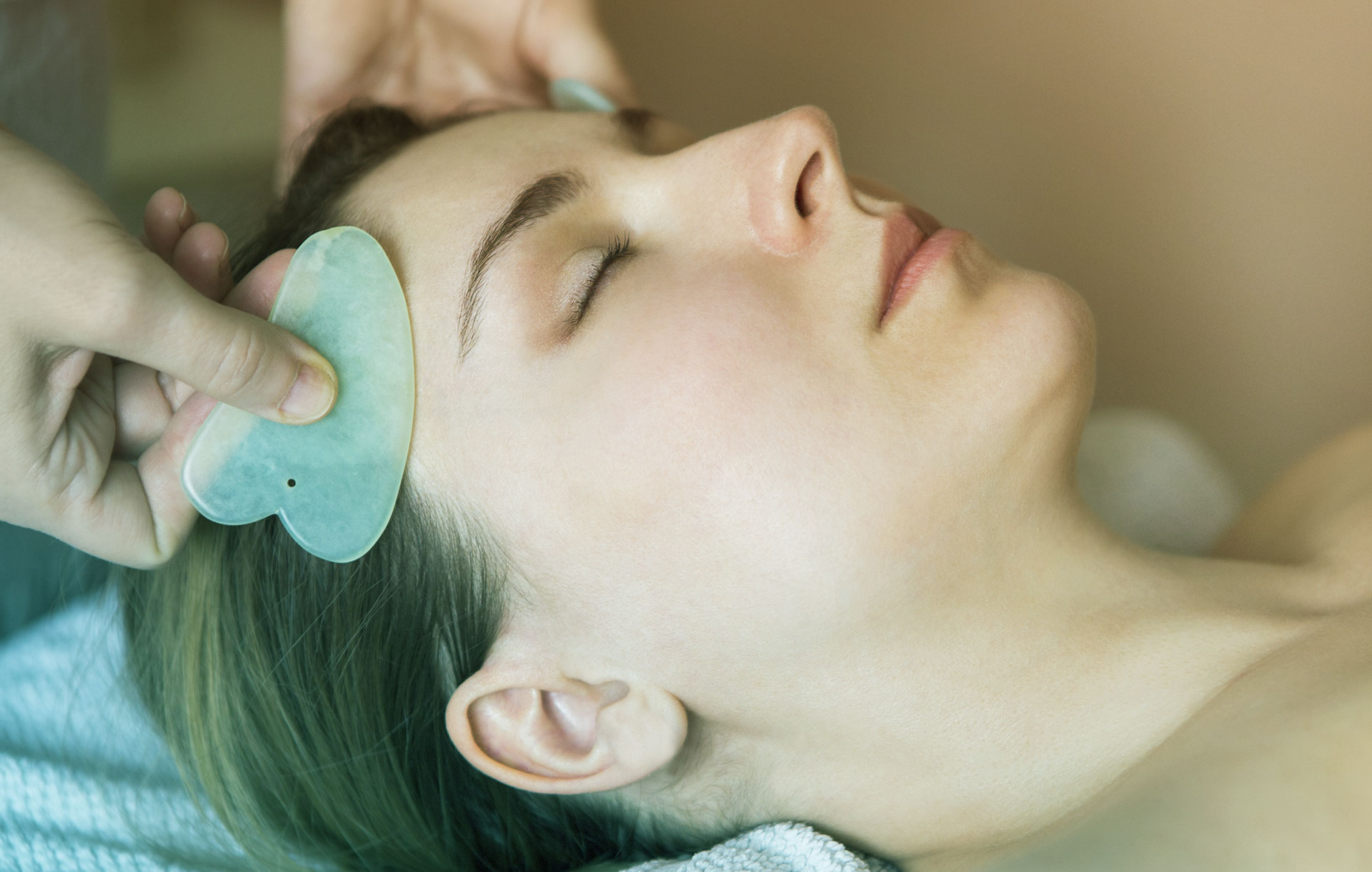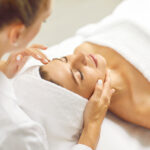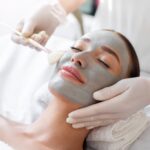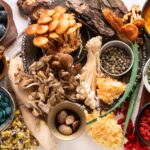
A closer look at the angles and edges of the stone
GUA SHA: a word that’s been heard and has rippled throughout the world with die hard followers and skeptics in equal form. It’s a popularized facial massage, which has been an industry standard, but perhaps overlooked and undervalued in its ability to shape the face and regulate the health of the skin. Facial massage is where the magic happens. It supports the skin’s function and increases the receptibility of the products that are applied. It can be argued that it’s the most important part of any facial and if true, Gua Sha may well be considered the sorcerer’s wand. If I’ve lost you by entertaining the idea that gliding a stone on the surface of the skin can create fundamental shifts in the health of the skin, let us peel back the layers to understand the science and skill behind the movements and the benefits of each angle and edges of the stone.
THE SCIENCE
Facial Gua Sha is part of modern Eastern Asian beauty therapy. It stems from modifications to the original friction-based technique of Gua Sha practiced on the body. It uses the same or similar tools, but the technique is much gentler and tailored to the delicate tissues of the face and neck. Facial Gua Sha encourages the beneficial flow of blood and fluids to and from the face. It stimulates the activation of acupressure points that lift, tone, and use your body’s resources to heal and slow the visible signs of aging.
[ihc-hide-content ihc_mb_type=”show” ihc_mb_who=”2,4,5,6,7″ ihc_mb_template=”-1″ ]
This simple yet powerful therapy brings about a fundamental change in the skin by clearing stagnation and accumulation in the tissues, and the “channel pathways” of Eastern Asian Medical Theory. By clearing these pathways, we are able to simultaneously create space within the tissue for the healthy exchange of nutrients and wastes that are essential for vibrant skin.
It’s important to understand that many of the present-day adaptations are not solely based on Traditional Chinese Medical (TCM) theory. In most cases, it’s a “fusion” of facial massage modalities, using the edges and angles of a Gua Sha stone to manipulate the tissue in a way that supports the natural function of the skin.
THE SKILL
The effectiveness of Gua Sha comes from the underlying movement that is created and the chain reaction that occurs when the systems that support the skin are ignited. The varying edges and the angle in which the stone connects with the skin and the pressure used determines the benefit. Having a set of tools with distinctive degrees of access to every layer of the skin allows you to address a bevy of skincare concerns.
THE STONE
Not all Gua Sha stones are created equal or serve the same purpose. They are found in all shapes and sizes with hand-carved features distinguishing them from another, which may seem insignificant to an untrained eye, but each of these distinctive characteristics and features serve a unique purpose and are of the utmost importance during a treatment.
What they ALL have in common is their basic ability to connect with the skin, which is the fundamental aspect of Gua Sha. Their uniqueness lies in the careful design and the superior ability to contour and navigate meticulously around the natural geography of the skin—allowing you to switch from one edge to another based on the intention and needs of the skin.
LET THE STONE DO THE WORK
The depth and range of possibilities available includes Gua Sha and facial massage stones that are ergonomi cally designed, etched with ridges and teeth, gentle hooks and rounded tips to smooth paddles and beveled edges that do the work for you.
Combed Teeth: Similar to fascia ridges but designed to access and care for the health of the scalp and tissue and muscles that continue beyond the hairline.
Elongated hook or bow: Acts like a scoop to combat “turkey neck” and under eye bags by removing excess fluids that accumulate under the chin and eyes.
U or H-shaped Notch: Clears stagnation along the jawline. Engages the tissue along the spine and neck muscles.
Beveled Edges: Anchor + glide (aka edging) is a technique using the beveled edges to smooth the connective tissue where fine lines and wrinkles manifest and become visible on the surface.
Handle | Fascia rolling: Acts like a foam roller to relieve myofascial tension, reduce inflammation, puffiness and pain in the jaw from grinding or clenching your teeth. Helps reduce migraines and tension headaches.
Acupressure | Reflexology Tip: Effective for facial reflexology, or to activate acupressure points. Soothes and erases brow tension, eyes straining and knots deeply seated in the muscles.
Fascia Ridges: Energy runs in undulating patterns, so the teeth allow you to access the ebbs in order to maintain the flow. On a physical level, they’re akin to “tilling the soil” and help irrigate the tissue, liberate cellular debris and unearth the healthy skin within.
Curved Wave: Sculpt, lift and smooth the complexion. Connects and engages the tissue like a windshield wiper to aid the transportation of excess fluids. Reduce inflammation and create space and an optimal environment for the increased production of collagen and elastin and hyaluronic acid.
Connective Tissue | Manual Lymphatic Ridges:
Acts like a “squeegee” on the skin to direct excess fluids and iron out fine lines and deep wrinkles in the connective tissue.
Rippled Double-S Wave: Features two smaller concaves that make it easier to maintain connection as you navigate the smaller contours and angles of the neck and face. Hugs and contours the jawline, cheeks, eyes, spine and trachea.
Beveled Paddle: Creates a unidirectional rocking motion that ignites the flow of lymph and the process of purifying the tissue by directing cellular waste away from the tissue.
Weeble Wobble Mushroom Caps: Melt tension and unwind bound fascia that acts like a dam in a river, restricting the flow of oxygen, blood and essential fluids needed to irrigate, hydrate and feed the tissue.
Although, it’s important to be properly trained and understand how to use the different angles and edges of the stone, the popularity comes from being able to accomplish fundamental changes in the skin whether you fully understand the medical theory or not. By simply increasing movement through massage and restoring inner mobility, the skin is able to naturally clear deleterious obstructions that lead to acne, rosacea, puffiness, dark circles and sensitivities. By manipulating the movements of the Gua Sha stone and adjusting the angles and edge, we can focus on the superficial layers as well as the underlying connective tissue and muscle movement to repattern the way the skin ages.
[/ihc-hide-content]












